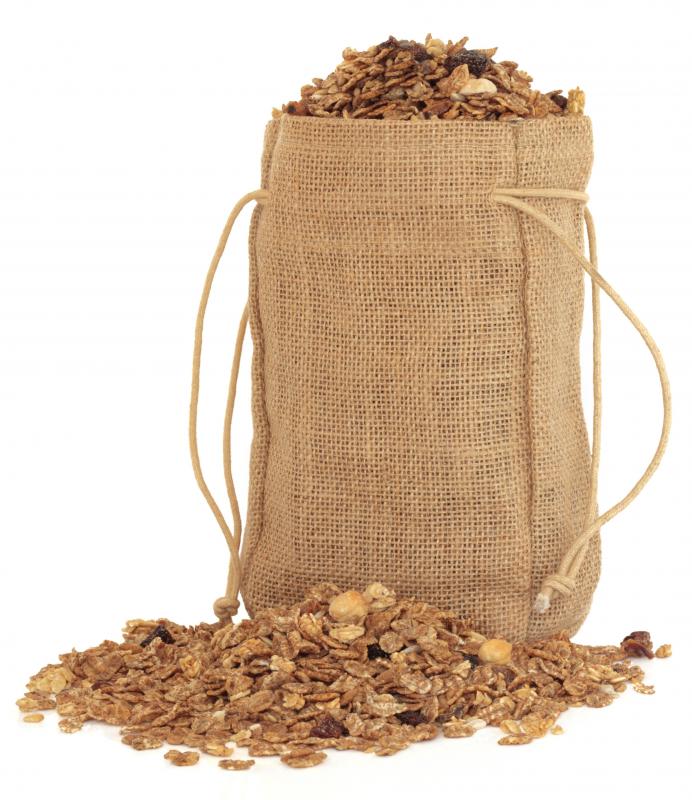At WiseGEEK, we're committed to delivering accurate, trustworthy information. Our expert-authored content is rigorously fact-checked and sourced from credible authorities. Discover how we uphold the highest standards in providing you with reliable knowledge.
What are the Different Types of Soluble Fiber Foods?
Fiber is essentially the parts of a plant that, when eaten, cannot be broken down for digestion by the human body. There are two types of fiber: insoluble fiber, which does not dissolve in water, and soluble fiber, which does. When consumed in adequate amounts each day, soluble fiber can bring about significant health benefits, such as improved cholesterol levels and regulated blood sugar balances. Learning to recognize soluble fiber foods can be a valuable first step toward improving one’s diet and overall health.
As fiber is derived from plants, some of the most beneficial soluble fiber foods are those which have not been broken down from their original plant form — namely fresh vegetables, fruits, and legumes. Vegetables high in soluble fiber include potatoes, broccoli, and carrots. Fruits include apples, plums, and citrus fruits. Among the best legume sources of soluble fiber are peas and pinto beans.

Grain and cereals are another important source of soluble fiber foods. Again, the less the fiber source has been broken down from its original form, the higher its soluble fiber content tends to be. Thus, whole grain oats and barley are two of the best grain-derived soluble fiber sources.
Cereals and grains are commonly present in more processed forms in foods like bread, pasta, and breakfast cereal. Whether these products are high soluble fiber foods depends on the extent to which they have been refined. White breads and pastas are usually highly refined, leaving little of the grain from which they are made intact. As a result, these products tend to be low in soluble fiber. Comparatively, whole grain pastas, breads, and cereals usually contain fair amounts of soluble fiber, and should be chosen over highly processed grain products.

Choosing high soluble fiber foods can have important health benefits. Soluble fiber can reduce the body’s levels of low-density lipoprotein (LDL) cholesterol, resulting in reduced overall cholesterol. This cholesterol reduction can translate to improved heart health. In addition, soluble fiber can reduce the rate at which the body absorbs sugar, thus providing a natural method for regulating the blood sugar.

The American Heart Association recommends that the average adult should attempt to consume around 25 grams of fiber each day. In order to experience cholesterol-lowering benefits, some physicians suggest that at least three of these 25 grams should consist of soluble fiber. To determine the fiber content of store-bought food products, study the nutrition facts label included on their packaging.
AS FEATURED ON:
AS FEATURED ON:
















Discussion Comments
Do all fruits and vegetables have roughage?
To be clear, the fact that a food doesn't say on its packaging that it has soluble fiber doesn't necessarily mean that it does not. Some breakfast cereals and packaged breads will make mention of it, but not all foods with soluble fiber will mention it. Read the ingredients! Insoluble fiber is also important it's much more prevalent (note the the article mentioned that just a small portion of your fiber intake will be soluble).
And, of course, the most nutritious foods have no packaging, because they are fresh fruits and vegetables! You probably were taught either the food pyramid, with grains at the bottom, or the old "four food groups" when you were a kid.
But if you want to eat healthy (assuming that you are not underweight, which comes with special needs), think about eating your vegetables and fruits *first.* They are the most nutritious and should be the biggest chunk of your diet. Think of carbohydrates (bread, pasta, rice, etc., preferably whole-grain) and protein foods like eggs, meat, and dairy as being flavorings for your vegetables, which should be the main attraction. Eat like that and soluble fiber isn't the only nutrient you'll be loading up on!
If you're trying to get started eating healthier, foods rich in soluble fiber are a good thing to add. But if you have a lot of changes to make, don't try to do it all at once - you'll crash and burn and go right back to your old way of eating.
Instead, think of starting with one thing. Is there one thing you eat each day that you could replace with an apple, a banana, a handful of grapes? Make that one healthy, easy change and live with it for a while. (If you are sedentary, meanwhile add just a smidge of additional physical activity to your day, even if it's 15 minutes of tidying up or a three-block walk.)
The tiny changes will feel good and soon you'll want to make more and will be ready to. Where can you cut a refined carb (i.e., white bread, pasta, etc.) and replace with a whole grain or even a vegetable? (For instance, spaghetti squash instead of pasta.)
Post your comments